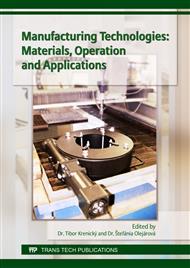p.88
p.96
p.107
p.119
p.127
p.136
p.142
p.149
p.155
Dynamics of a Moulding Cooling at Injection of Plastics
Abstract:
For a regulation of moulding cooling time course in a mould it is necessary to derive an equation of the mould temperature dependence on the moulding temperature as the equation of the regulation system. Amplitude, phase and transition characteristic are for R=1 and P=1 identical as for the action quantity. Amplitude, phase and transition characteristic of the action quantity and the control of the regulation circuit at use of the proportional regulator show that the circuit is stable a periodic. From the amplitude, phase and transition characteristic of the regulation circuit defect it is seen that the defect in the regulation circuit is relatively fast lowered. From the mentioned conclusions it is seen that the moulding cooling in the mould at injection of plastics with the proportional regulator introduces the regulation with relatively favourable regulation properties.
Info:
Periodical:
Pages:
149-154
Citation:
Online since:
September 2017
Authors:
Keywords:
Price:
Сopyright:
© 2017 Trans Tech Publications Ltd. All Rights Reserved
Share:
Citation:


